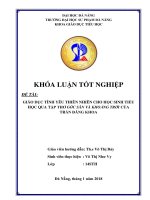tran dang khoa fgw dn 577577 0
Bạn đang xem bản rút gọn của tài liệu. Xem và tải ngay bản đầy đủ của tài liệu tại đây (5.69 MB, 66 trang )
#2 UNIVERSITYof BTEC
is? GREENWICH
Alliance with ago. Education
Student’s
UNIVERSITYof ‘BTEC
GREENWICH
Alliance with ago. Education
Oo
Verifier’s
UNIVERSITY„ m4
e
Alliance vith ago. Education se
I. Analyse the evolution and fundamental concepts of Cloud Computing (P1) 5
1. Evolution of Cloud Computing 5
2. What is Cloud Computing 7
3. Types of Cloud Computing 8
4. Benefits and challenges of Cloud Computing 11
4.1 Benefit is Cloud Computing 11
4 2. Challenges of Cloud Computing 12
5. How does Cloud Work and use of Cloud Computing 15
II. Design an appropriate architectural Cloud Computing framework for a given scenario.
(P2) 17
1. Cloud Computing architecture 17
2. Components Of Cloud Computing Architecture 18
2.1. What is Front-End Cloud Architecture? 19
2.2. What is Back-end Cloud Architecture? 19
2 3. Layered Architecture of Cloud 21
2. Architecture design for ATN organization 24
III. Define an appropriate deployment model for a given scenario. (P3) 25
1. What Is A Cloud Deployment Model? 25
1.1. Different types of Cloud Computing Deployment Model. 25
12. Comparison between Public, Private, Hybrid, and Community Cloud: 27
2. Architecture design for ATN organization 27
21. Qualitative Analysis 27
2 2. Quantitative Analysis 28
IV. Compare the service models for choosing an adequate model for a given scenario. (P4) 29
I. Compare 03 service models (IaaS, PaaS, SaaS) 29
Il. A Service Model For ATN Company 31
1. Qualitative Analysis. 31
. Qualitative Analysis 32
References 33
“g8... UNIVERSITYof °
Alliance vith ago. Education “BTEC
Figure 1: Evolution of Cloud Computing organization 5
Figure 2: Cloud Computing
Figure 3: Types of Cloud Computing 9
Figure 4: Benefit is Cloud Computing 11
Figure 5: Challenges of Cloud Computing 13
Figure 6: Public Cloud. 15
Figure 7: Private Cloud 16
Figure 8: Cloud Computing architecture 17
Figure 9: Architecture of Cloud Computing 18
Figure 10: Front-End Cloud Architecture 19
Figure 11: Back-end Cloud Architecture? 20
Figure 12: Layered Architecture of Cloud 22
Figure 13: Architecture Cloud Computing digram for ATN 24
Figure 14: Table Quantitative Analysis 29
UNIVERSITY of un
o
Alliance vith ago. Education °
I. Analyse the evolution and fundamental concepts of Cloud
Computing (P1)
1. Evolution of Cloud Computing
Cloud computing is all about renting computing services. This idea first came in the 1950s. In making
cloud computing what it is today, five technologies played a vital role. These are distributed systems
and its peripherals, virtualization, web 2.0, service orientation, and utility computing. (Anukruti16,
09 Mar, 2023)
Utility Cloud
Computing
Computing
2007:
Evolution of Cloud Computing
e Distributed Systems:
It is a composition of multiple independent systems but all of them are depicted as a single entity to
the users. The purpose of distributed systems is to share resources and also use them effectively and
efficiently. Distributed systems possess characteristics such as scalability, concurrency, continuous
availability, heterogeneity, and independence in failures. But the main problem with this system was
that all the systems were required to be present at the same geographical location. Thus to solve this
problem, distributed computing led to three more types of computing and they were-Mainframe
computing, cluster computing, and grid computing.
e Mainframe computing:
SỒ GNEENWICHÍ ‘BT E C
stone win IG cs °
Mainframes which first came into existence in 1951 are highly powerful and reliable computing
machines. These are responsible for handling large data such as massive input-output operations.
Even today these are used for bulk processing tasks such as online transactions etc. These systems
have almost no downtime with high fault tolerance. After distributed computing, these increased the
processing capabilities of the system. But these were very expensive. To reduce this cost, cluster
computing came as an alternative to mainframe technology.
e Cluster computing:
In 1980s, cluster computing came as an alternative to mainframe computing. Each machine in the
cluster was connected to each other by a network with high bandwidth. These were way cheaper than
those mainframe systems. These were equally capable of high computations. Also, new nodes could
easily be added to the cluster if it was required. Thus, the problem of the cost was solved to some
extent but the problem related to geographical restrictions still pertained. To solve this, the concept
of grid computing was introduced.
e Grid computing:
In 1990s, the concept of grid computing was introduced. It means that different systems were placed
at entirely different geographical locations and these all were connected via the internet. These
systems belonged to different organizations and thus the grid consisted of heterogeneous nodes.
Although it solved some problems but new problems emerged as the distance between the nodes
increased. The main problem which was encountered was the low availability of high bandwidth
connectivity and with it other network associated issues. Thus. cloud computing is often referred to
as “Successor of grid computing”.
- Viwrtualigatian:
° vartuauzauun.
It was introduced nearly 40 years back. It refers to the process of creating a virtual layer over the
hardware which allows the user to run multiple instances simultaneously on the hardware. It is a key
technology used in cloud computing. It is the base on which major cloud computing services such as
Amazon EC2, VMware vCloud, etc work on. Hardware virtualization is still one of the most common
types of virtualization.
e Web 2.0:
It is the interface through which the cloud computing services interact with the clients. It is because
of Web 2.0 that we have interactive and dynamic web pages. It also increases flexibility among web
Ca UNIVERSITY of examples of web ‘BTEC
GREENWICH
possible because 2.0 include Google Maps, Facebook, Twitter, etc. Needless to say,
Alliance with ago. Education
of this technology only. It gained major popularity in 2004.
pages. Popular
social media is
e Service orientation:
It acts as a reference model for cloud computing. It supports low-cost, flexible, and evolvable
applications. Two important concepts were introduced in this computing model. These were Quality
of Service (QoS) which also includes the SLA (Service Level Agreement) and Software as a Service
(SaaS).
e Utility computing:
It is a computing model that defines service provisioning techniques for services such as compute
services along with other major services such as storage, infrastructure, etc which are provisioned on
a pay-per-use basis.
2. What is Cloud Computing
Cloud computing is on-demand access, via the internet, to computing resources-applications, servers
(physical servers and virtual servers), data storage, development tools, networking capabilities, and
more-hosted at a remote data center managed by a cloud services provider (or CSP). The CSP makes
these resources available for a monthly subscription fee or bills them according to usage. (IBM, 2022).
CLOUD COMPUTING
ARCHITECTURE
eatCloudL = Computing aStorage
| ta
Servers Virtual Software Application
Tie Desktop Platform Data
« ù | rare 5
Switch
5 Sl Mobile Gk Gs Gs
Laptop Printer Desktop Desktop
Desktop
Ca UNIVERSITY of ?
Alliance with ago. Education ,
Compared to traditional on-premises IT, and depending on the cloud services you select, cloud
computing helps do the following:
- Lower IT costs: Cloud lets you offload some or most of the costs and effort of purchasing,
installing, configuring, and managing your own on-premises infrastructure.
- Improve agility and time-to-value: With the cloud, your organization can start using
enterprise applications in minutes, instead of waiting weeks or months for IT to respond toa
request, purchase and configure supporting hardware, and install software. Cloud also lets you
empower certain users-specifically developers and data scientists-to help themselves to
software and support infrastructure.
- Scale more easily and cost-effectively: Cloud provides elasticity-instead of purchasing
excess capacity that sits unused during slow periods, you can scale capacity up and down in
response to spikes and dips in traffic. You can also take advantage of your cloud provider’s
global network to spread your applications closer to users around the world.
m . en 1 . , 4 c . “1 . 1 1 “1 . 1 1 1 tome «= 1 1
UNIVERSITYof
GREENWICH
Alliance vith Education
| TYPES OF CLOUD COMPUTING .
Based on Based on
Deployment Service Model
aN SD
UNIVERSITY of °
Alliance with ago. Education °
A hybrid cloud uses a combination of public and private cloud features. The “best of both worlds”
cloud model allows a shift of workloads between private and public clouds as the computing and cost
requirements change. When the demand for computing and processing fluctuates, the hybrid cloud
opens a new window that allows businesses to scale their on-premises infrastructure up to the public
cloud to handle the overflow while ensuring that no third-party data centers have access to their data.
In a hybrid cloud model, companies only pay for the resources they use temporarily instead of
purchasing and maintaining resources that may not be used for an extended period. In short, a hybrid
cloud offers the benefits of a public cloud without its security risks.
Based on the service model, the cloud can be categorized into IaaS (Infrastructure-as-a-Service), PaaS
(Platform-as-a-Service), and SaaS (Software-as-a-Service). Let’s take a look at each one. (BasuMallick,
February 9, 2022 ).
e Infrastructure as a service (IaaS)
Infrastructure as a service or IaaS is a type of cloud computing in which a service provider is
responsible for providing servers, storage, and networking over a virtual interface. In this service, the
user doesn’t need to manage the cloud infrastructure but has control over the storage, operating
systems, and deployed applications. Instead of the user, a third-party vendor hosts the hardware,
software, servers, storage, and other infrastructure components. The vendor also hosts the user’s
applications and maintains a backup.
e Platform asa service (PaaS)
Platform as a service or PaaS is a type of cloud computing that provides a development and
deployment environment in the cloud that allows users to develop and run applications without the
complexity of building or maintaining the infrastructure. It provides users with resources to develop
cloud-based applications. In this type of service, a user purchases the resources from a vendor on a
pay-as-you-go basis and can access them over a secure connection. PaaS doesn’t require users to
manage the underlying infrastructure, i.e., the network, servers, operating systems, or storage, but
gives them control over the deployed applications. This allows organizations to focus on the
deployment and management of their applications by freeing them of the responsibility of software
maintenance, planning, and resource procurement.
e Software asa service (SaaS)









